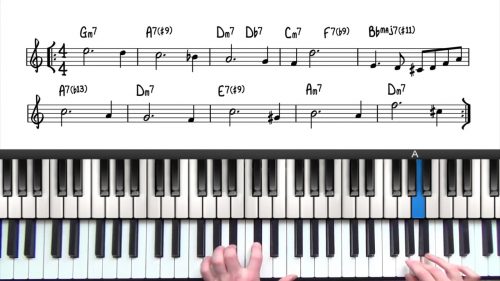Major Grooves: Comping Patterns & Voicings
In this lesson, we explore rhythms, voicings and comping patterns for the major 25s, 251s, & 1625s. You can use these voicings and rhythmic grooves when playing a wide variety of songs in Bossa Nova or Samba style.
1-Chord Vamp Over Major Harmony
For the first example, we will start with major harmony using a 1-chord vamp. This will allow us to focus on the rhythm. This rhythm is one of the most useful comping patterns for you to learn and memorise so pay attention.
This versatile comping pattern that can be used as a base to create your own style of comping.
Rootless Voicings In The Right Hand
Rootless voicings containing extensions and alterations are well-suited to the Brazilian style. For our first example, we take a major chord and add the 6 and the 9 to our right hand to get a rich and colourful rootless comping voicing.
Keeping The Pulse Of The 16th Note
Once you have internalised the common comping pattern, the next step is to lock into the pulse of the 16th note and use these as ghost notes in your comping patterns.
The Reverse Comping Pattern
For our first comping pattern, the right-hand chords started on the downbeat. We can also displace this starting position to achieve a different pattern. Depending on the style, or the song you are playing, these different starting points can be a useful tool.
Comping Patterns for 251s and 1625s
We then introduce more chords into our 2-bar vamp. Starting with the 251 progression we apply the comping patterns to the chords Em9 – A13 – Dmaj13.
We then take this a step further and introduce the VI7 chord to create a 4-chord vamp. This circular progression is a wonderful exercise to develop your sense of groove.
Lesson Downloads
-
Major Vamps & Comping Patterns File Type: pdf
Practice Tips
-
Start by following along with the clap exercises to help learn and internalise the comping rhythm.
-
As demonstrated, keep the pulse of the 16th note so that you can use these as ghost notes in your comping patterns.
-
Practice starting on both the downbeat, and the upbeat.
-
Practice starting in different inversions.
-
Move up and down the piano between the inversions whilst circling around the vamp.
-
Play these comping patterns around 251s in all 12 keys.
-
For those looking for a challenge... take these comping patterns around the 1625 progression in all 12 keys.









Please add speed control to this video :-)
Hey Fred 👋
The speed controls added now – thanks for letting me know about this.
If you spot this again just let me know and I will fix.
Cheers,
Hayden
Jovino,
what is comping in Portuguese? Acompanhamento?
And vamping? Levada? batida?
Lost in Translation
¯\_(ツ)_/¯
I think comping is acompanhamento.
Groove is the levada, the one Jovino is teaching I learned as levada de samba. But I am relearning with him and I understand it better now.
I’m not sure about the best word for vamping. Let’s see what Jovino says.
Great lesson! Perfeito!